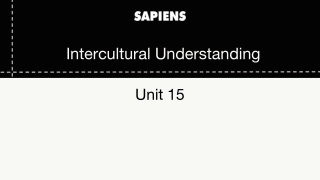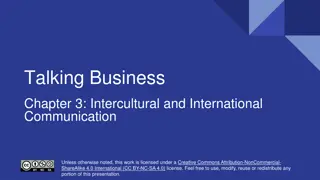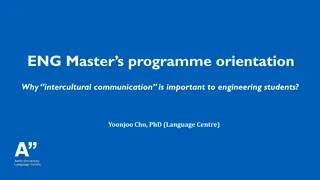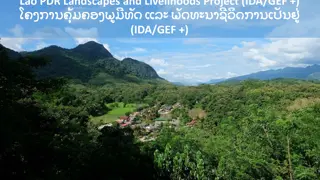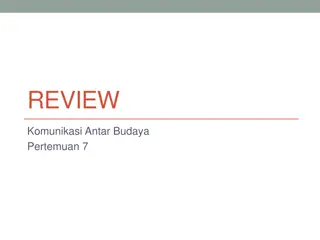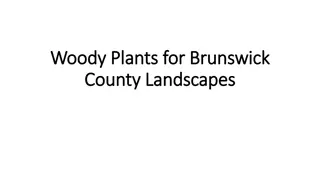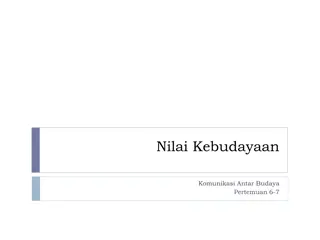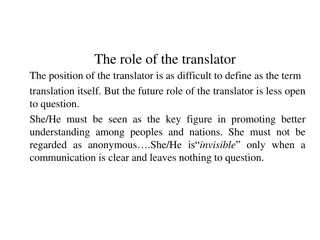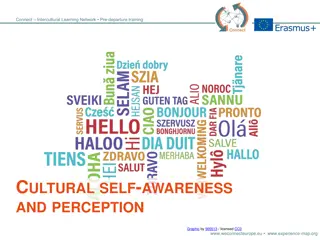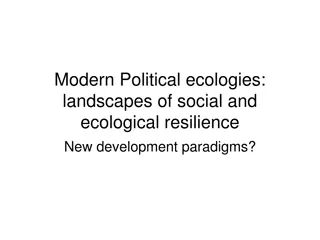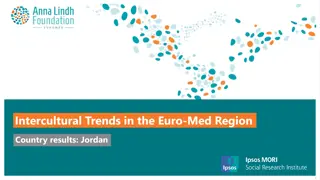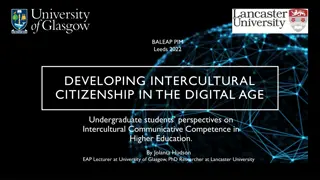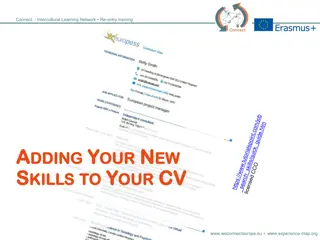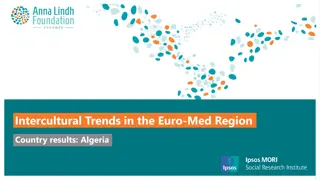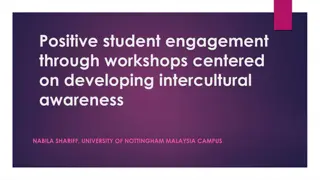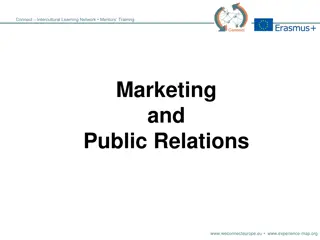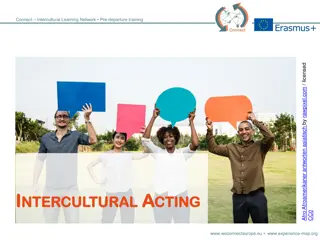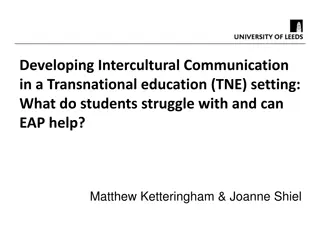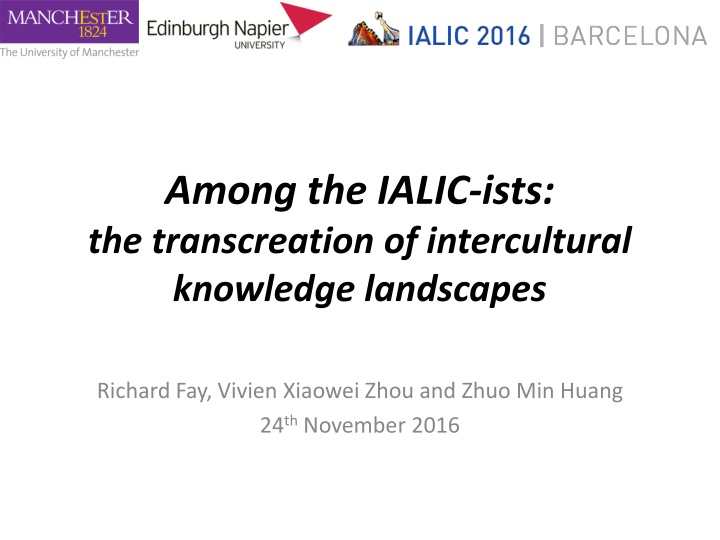
Transcreation of Intercultural Knowledge Landscapes
Study delves into the evolving cultures of IALIC, focusing on the intercultural communication field's dynamics, influences, and emergent landscapes. By examining textual insights from conferences, insights into the association's culture and direction are revealed
Download Presentation

Please find below an Image/Link to download the presentation.
The content on the website is provided AS IS for your information and personal use only. It may not be sold, licensed, or shared on other websites without obtaining consent from the author. If you encounter any issues during the download, it is possible that the publisher has removed the file from their server.
You are allowed to download the files provided on this website for personal or commercial use, subject to the condition that they are used lawfully. All files are the property of their respective owners.
The content on the website is provided AS IS for your information and personal use only. It may not be sold, licensed, or shared on other websites without obtaining consent from the author.
E N D
Presentation Transcript
Among the IALIC-ists: the transcreation of intercultural knowledge landscapes Richard Fay, Vivien Xiaowei Zhou and Zhuo Min Huang 24thNovember 2016
Structure 1. Background to the study 2. Methodological and Conceptual aspects (work in progress) 3. Some outcomes/insights so far 4. Initial attempts to map shaping influences ...
Evolving/Emergent Cultures of IALIC (1) Some starting points (1) ... the field of IC (and IALIC in particular) is relatively young, and dynamic, and has interesting fault-lines : e.g. meeting points between: cross-cultural (essentialist-leaning) approaches and more critical perspectives; education- vs business- vs language-oriented foci; Global North and Global South theorising; etc represents a rich site/space of/for knowledge-work , i.e. intercultural communication viewed as an emergent knowledge landscape (Clandinin & Connelly) Exploration of such knowledge-work and this emergent landscape might reveal something about: the field of IC itself (what our understandings at this juncture? Where have come from? Where might they be headed? etc) the processes (e.g. transcreation) through which this landscape is evolving the possible shaping influences on the emergent culture of IALIC
Evolving/Emergent Cultures of IALIC (2) Some starting points (2) ... possible lines of exploration: Our title intentionally echoes Tommy Dahl n s (1997) ethnography of the developing field of intercultural communication. His focus = the emergent professional cultures (of IC) (e.g. SIETAR) Our focus = on the emergent (researcher-practitioner) cultures of an association (i.e. IALIC). Whereas Dahl n worked ethnographically, we are intrigued by John Swales (1998) study of texts (i.e. a textography) within a university building to understand what happens in it and what it means to those involved We are focusing on IALIC texts to better understand what is happening in our association and what this means for us. Also: Dwight Atkinson s (1999) study of corpus of 1984-1998 culture articles in TESOL Quarterly.
Initial Exploration: Piloting Moves Focus What can we learn about the emerging cultures of IALIC (as a key intercultural association) from a study of the texts that its members write for its conferences? Develop a text corpus based on: Calls for Papers for recent (globally-distributed) IALIC conferences (e.g. Durham 2012, Beijing 2015) Sets of recent IALIC conference titles, abstracts, and keywords Focus on terms/ideas used and authors cited Trial analytical possibilities including: content analysis, word-clouds/wordles/word-trees, corpus/concordancing techniques, network analysis . Work in progress (initial stages)
Initial Exploration: Conceptual Underpinning IALIC annual conferences, staged alternately in Europe and Asia, represent a site for the transcreation of an intercultural communication knowledge-landscape. Building on previous work (Huang, Fay and White, 2015; forthcoming, 2017), the term transcreation refers to the transformative possibilities and complexities (i.e. across time, space, languages and cultures, disciplines and domains, etc.) of knowledge-work in our increasingly interconnected world. It is partly through such transcreational processes that knowledge- landscapes (Clandinin and Connelly, 1995) evolve and develop. The transcreational processes are shaped by influences such as the locationof the conference (i.e. geographical), its the hosts (i.e. institutional, departmental, disciplinary), and Calls for Papers (i.e. thematic), etc. The emerging cultures of IALIC can be explored diachronically and synchronically.
Examples: high-frequency words in Calls for Papers Durham (2012) Word Beijing (2015) Word Count Count intercultural communication education language cultural dialogue asian linguistics research competence international practices theories applied approaches challenges china conflict current dimensions disciplines 25 20 9 9 5 5 4 4 4 3 3 3 3 2 2 2 2 2 2 2 2 intercultural communication language practices communities local conflict education international social development new research cultures researchers change chinese foreign identity management multilingual 21 14 13 8 7 7 6 6 6 6 5 5 5 4 4 3 3 3 3 3 3
Examples: Key-themes in Calls for Papers Durham (2012) Beijing (2015) Intercultural communication practices in language education e.g. Multilingual, multicultural practices and language teachers; Development of intercultural competence; New technology and intercultural education intercultural communication into the 21st century internationalisation and languages/intercultural communication/education the cultural/intercultural dimensions of language learning and teaching (pedagogies) Intercultural conflict and conflict management in communities e.g.Intercultural conflict and emotional management; Power, politics and conflict negotiation emerging theories and methodologies for intercultural communication and language research researching multilingually intercultural (communication) competence and its assessment Preservation and exploration of indigenous/local/native cultures e.g. Ethnocentric bias in intercultural (competency) models; Diversity and heterogeneity in indigenous/local/native cultures; Change, fusion and recreation of local cultures; Intercultural competency models revisited in local cultural contexts interfaith/intercultural dialogue ethical communication; intercultural responsibility global/local citizenship and the intercultural conflict, mediation, negotiation and peace communication e.g. Academic socialization of international students;Language and identity development Migration and international relocation plurilingualism; bilingual and multilingual communication and education political/historical/religious/geographical influences on intercultural communication e.g. Intercultural communication in the workplace;Translation and intercultural communication; Language, identity and international crime Other institutional practices linguistics; sociolinguistics; applied linguistics new technology and intercultural communication
Examples: Keywords in abstracts Beijing (2015) -- keywords tagged by authors for their abstracts Word Count intercultural communication cultural culture competence education language English Chinese analysis discourse china teaching awareness identity translation communicative critical cross 58 29 28 22 19 15 15 14 13 12 11 9 9 8 7 7 6 6 6
Examples: Wordcloud of cited-authors Beijing (2015)
Aims: to promote critical engagement with the notion of mediating between cultures and languages; to explore the role of technology in bridging between diverse languages and cultures; to explore the role of broker in cross-cultural situations, including growing instances of child language brokers ; to promote understanding of how language brokering is perceived by researchers and practitioners from cross-cultural situations; to provide a forum for a critique of existing analytical models of culture and language mediating practices that integrate current theories of language and intercultural communication; to provide a forum on ways in which research into language and culture mediation can inform teachers praxis. Themes: Bridging of languages and cultures in the workplace Translanguaging practices New approaches to analysing language and cultural mediation Research models for language and culture brokering Language and culture brokering and technology
Exploring shaping influences on IALIC cultures 1991 2016 Diachronic IC fields Themes Synchronic IALIC Cultures Location Time Durham Beijing Barcelona Possible shaping influences: points in time, geographic locations, host departments and disciplines, thematic foci, .
Some Concluding Thoughts Our initial explorations (a kind of textography) of IALIC conference-related texts (e.g. Calls for Papers, Paper/Plenary Titles, Abstracts, Keywords, Special Issues of L&IC) suggests that evolving (over time) and emergent (at moments in time) cultures of IALIC can be mapped. Such mapping might enable us to consider what influences shape these cultures (e.g. location, hosting institution/department, current disciplinary debates, timing, thematic focus of CfP). The underpinning conceptual apparatus (of knowledge-landscapes and transcreational processes) seems helpful but needs more work. Mapping each conference (synchronic textography) might reveal some of the dynamics at play as foregrounded by the location, the theme etc Mapping the ongoing cultures of IALIC (diachronic textography) might reveal something about the enduring plausibility and explanatory power of some ways of understanding (e.g. national/regional discourses) as well as track the development of alternative ways e.g. anti-essentialist, critical approaches). Such mapping might enable IALIC to better understand its role in our IC field and how perhaps to steer future developments in it (e.g. upcoming CfP etc).
Examples: Word-trees of Calls for Papers Durham (2012) Beijing (2015)

